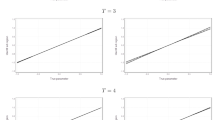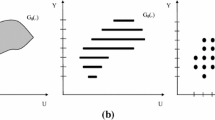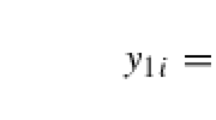Abstract
This paper studies identification in a binary choice panel data model with choice probabilities depending on a lagged outcome, additional observed regressors and an unobserved unit-specific effect. It is shown that with two consecutive periods of data identification is not possible (in a neighborhood of zero), even in the logistic case.
Similar content being viewed by others
Avoid common mistakes on your manuscript.
1 Foreword from the editors
In 1993, Gary Chamberlain released Harvard Institute of Economic Research (HIER) discussion paper no. 1656, titled “Feedback in Panel Data.” The material in this paper appears to be a revision and extension of ideas that circulated at least as early as 1991, in a draft paper titled “Sequential Moment Conditions in Panel Data.” Some of the material in the earlier, 1991, paper appeared as a, now well-known, comment in the Journal of Business and Economic Statistics (Chamberlain 1992). The “Feedback in Panel Data” paper, however, remained unpublished for many years.
Prior to his passing in 2020, Gary submitted a version of the feedback paper to the Journal of Econometrics in connection with a conference that was held in his honor at Harvard University (Chamberlain 2022) (Manuel Arellano was among the participants at this conference). Before its eventual publication in 2022, the “Feedback in Panel Data” paper was not widely circulated and, to our knowledge, unavailable in any form online.
One version of the 1993 paper included a fifth and final section titled “Binary Response.” This material was not published as part of Chamberlain (2022). The “Binary Response” section contained two sets of results. The first, dealing with the identification of static binary choice models, can be found in Chamberlain (2010). The second part, which is reproduced below, deals with the identification of dynamic binary choice models.
Gary establishes that with two consecutive observations of a binary dependent variable, identification is not possible (in a neighborhood of zero), even in the logistic case. This result is not widely known, although it has been cited by, for example, Honoré and Kyriazidou (2000). Publishing this material makes it easily available to researchers worldwide for the first time.
Gary was a great admirer of Manuel Arellano’s research, and they engaged in many intellectual exchanges over the years. Gary would no doubt have wanted to celebrate and honor Manuel’s considerable achievements and scholarship. Including this short note in this special issue provides a way to do so.
Stéphane Bonhomme, Bryan Graham and Laura Hospido.
2 Identification in dynamic binary response
The outcome variable is binary. There are two periods of observation on each unit (\(T=2\)). The random vector \((y_{i1},y_{i2},x_{i1}',x_{i2}',c_{i})\) is independently and identically distributed for \(i=1,...,n\). We observe \(z_{i}'=(y_{i1},y_{i2},x_{i1}',x_{i2}')\); the (scalar) latent variable \(c_{i}\in \mathcal {R}\) is not observed. The binary variable \(y_{\textrm{it}}=0\) or 1, and \(x_{i}'=(x_{i1}',x_{i2}')\) has support \(X\subset \mathcal{{R}}^{J}\times \mathcal{{R}}^{J}\).
We assume that
The distribution function F is given as part of the prior specification; it is strictly increasing on the whole real line with a bounded, continuous derivative, and with \(\text{ lim}_{s\rightarrow \infty }\,F(s)=1\) and \(\text{ lim}_{s\rightarrow -\infty }\,F(s)=0\). The parameter space is \(\Theta =\Theta _{1}\times \Theta _{2}\times \Theta _{3}\), where \(\Theta _{1}\) is an open subset of \(\mathcal{{R}}\), \(\Theta _{2}\) is an open subset of \(\mathcal{{R}}^{J}\), and \(\Theta _{3}\) is an open subset of \(\mathcal{{R}}\), and \(\theta _{0}'\equiv (\alpha _{0},\beta _{0}',\gamma _{0})\in \Theta \). We assume that \(\Theta \) contains a neighborhood of 0. Define
Theorem 1
If X is bounded, then there is a point \((\alpha ,\gamma )\in \Theta _{1}\times \Theta _{3}\) such that identification fails in (1) for all \(\theta _{0}\) in a neighborhood of \((\alpha ,0,\gamma )\).
Proof
Define
Suppose that for some \((\alpha ,\gamma )\in \Theta _{1}\times \Theta _{3}\) and points \(c_{1},...,c_{4}\in \mathcal{{R}}\), we have \(H(x,c_{1},...,c_{4},\theta ^{*})\) nonsingular, where \(\theta ^{*}=(\alpha ,0,\gamma )\). Consider a convex combination
where \(\pi ^{*\prime }=(\pi _{1}^{*},...,\pi _{4}^{*})\), \(\pi _{j}^{*}>0\), and \(\sum _{j=1}^{4}\pi _{j}^{*}=1\). Let
where \(\theta _{0}\ne \theta ^{*}\) is any point in \(\Theta \) sufficiently close to \(\theta ^{*}\) that the inverse exists and \(\pi _{0j}(x)>0\) for all \(x\in X\); there is such a neighborhood of \(\theta ^{*}\) because X is bounded. Note that \(l'H=l'\), where l is a \(4\times 1\) vector of ones; hence \(l'H^{-1}=l'\) and \(l'\pi _{0}(x)=1\). Hence
and we cannot distinguish \(\theta _{0}\) from \(\theta ^{*}\).
We conclude that for every \((\alpha ,\gamma )\in \Theta _{1}\times \Theta _{3}\) we must have \(H(x,c_{1},...,c_{4},(\alpha ,0,\gamma ))\) singular for every choice of \(c_{1},...,c_{4}\in \mathcal{{R}}\). Otherwise identification fails for all \(\theta _{0}\) in some neighborhood of \((\alpha ,0,\gamma )\). So there must exist scalars \(\psi _{1},...,\psi _{4}\) (not all zero) such that
for all \(c\in \mathcal{{R}}\). Letting \(c\rightarrow \infty \) gives \(\psi _{4}=0\). Letting \(c\rightarrow -\infty \) gives \(\psi _{1}=0\). Hence we have
for all \((\alpha ,\gamma )\in \Theta _{1}\times \Theta _{3}\) and all \(c\in \mathcal{{R}}\).
Set \(\gamma =0\). Letting \(Q\equiv F/(1-F)\), we must have
setting \(c=0\) gives \(\psi _{3}/\psi _{2}=-Q(\alpha )/Q(0)\), and so
for all \(\alpha \in \Theta _{1}\) and all \(c\in \mathcal{{R}}\). The only positive, continuously differentiable solution to this form of Cauchy’s equation is
then, from \(F=Q/(1+Q)\) it follows
Now set \(\alpha =0\). Then, with \(G=1-F\), we have
setting \(c=0\) gives \(\psi _{2}/\psi _{3}=-G(\gamma )/G(0)\), and so
for all \(\gamma \in \Theta _{3}\) and all \(c\in \mathcal{{R}}\). The only positive, continuously differentiable solution to this form of Cauchy’s equation is
which implies that
So we have
and taking the derivative with respect to s gives
But this is a contradiction, since F is strictly increasing. So it is not possible to maintain the singularity condition on H, and identification fails for all \(\theta _{0}\) in some neighborhood of \((\alpha ,0,\gamma )\). Q.E.D. \(\square \)
Data availability
There are no data or codes in this paper.
References
Chamberlain G (1992) Comment: sequential moment restrictions in panel data. J Bus Econ Stat 10(2):20–26
Chamberlain G (2010) Binary response models for panel data: identification and information. Econometrica 78(1):159–168
Chamberlain G (2022) Feedback in panel data models. J Econom 226(1):4–20
Honoré BE, Kyriazidou E (2000) Panel data discrete choice models with lagged dependent variables. Econometrica 68(4):839–874
Author information
Authors and Affiliations
Ethics declarations
Conflict of interest
Not applicable.
Additional information
Publisher's Note
Springer Nature remains neutral with regard to jurisdictional claims in published maps and institutional affiliations.
Gary Chamberlain sadly passed away in 2020. The editors thank Manuel Arellano for providing a copy of Gary’s unpublished April 1993 draft “Feedback in Panel Data Models” from which the material reproduced below was drawn. Special thanks go to Laura Gehl, Gary’s daughter, for her permission to publish this material. Aside from a few small typo corrections, changes in equation numbering, and some re-working to avoid internal cross-references that make no sense outside the context of the full draft, the text from Sect. 2 onwards is as it appears in Sect. 5 of the April 1993 draft. The abstract is not Gary’s, but was written by the editors. The paper was re-typed and edited by Stéphane Bonhomme and Bryan Graham. Kevin Dano and Martin Mugnier kindly undertook additional proof-reading. Questions about this manuscript should be directed to Bryan Graham (e-mail: bryangraham@berkeley.edu).
Rights and permissions
Open Access This article is licensed under a Creative Commons Attribution 4.0 International License, which permits use, sharing, adaptation, distribution and reproduction in any medium or format, as long as you give appropriate credit to the original author(s) and the source, provide a link to the Creative Commons licence, and indicate if changes were made. The images or other third party material in this article are included in the article’s Creative Commons licence, unless indicated otherwise in a credit line to the material. If material is not included in the article’s Creative Commons licence and your intended use is not permitted by statutory regulation or exceeds the permitted use, you will need to obtain permission directly from the copyright holder. To view a copy of this licence, visit http://creativecommons.org/licenses/by/4.0/.
About this article
Cite this article
Chamberlain, G. Identification in dynamic binary choice models. SERIEs 14, 247–251 (2023). https://doi.org/10.1007/s13209-023-00276-0
Received:
Accepted:
Published:
Issue Date:
DOI: https://doi.org/10.1007/s13209-023-00276-0




